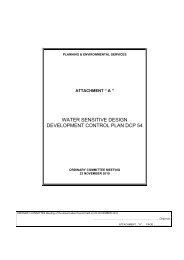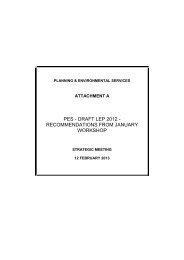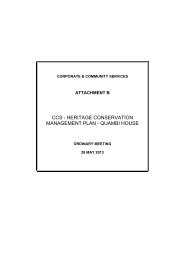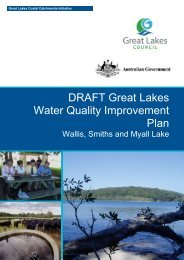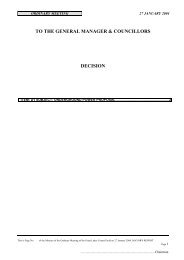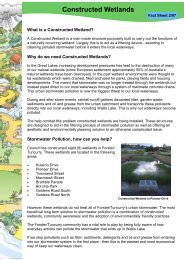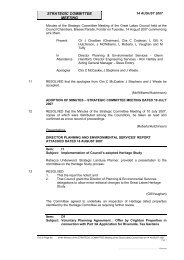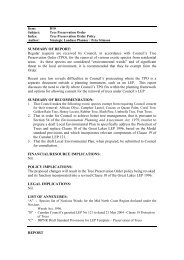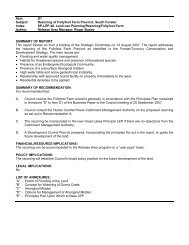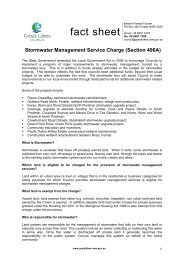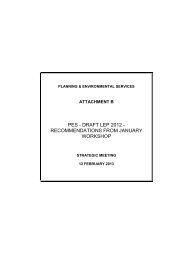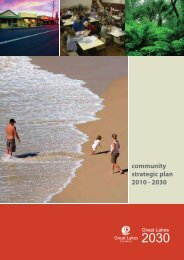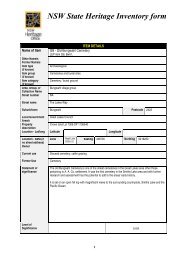13.2 The Wallis Lake Estuary Management Committee - Great Lakes ...
13.2 The Wallis Lake Estuary Management Committee - Great Lakes ...
13.2 The Wallis Lake Estuary Management Committee - Great Lakes ...
You also want an ePaper? Increase the reach of your titles
YUMPU automatically turns print PDFs into web optimized ePapers that Google loves.
<strong>Wallis</strong> <strong>Lake</strong> <strong>Estuary</strong> <strong>Management</strong> Plan<br />
Two studies were conducted whereby the benthic nutrient fluxes were measured under winter conditions (June<br />
2000) and summer conditions (Feb 2003) at 6 sites in total (Pipers Creek, <strong>Wallis</strong> Creek and Central Basin, Muddy<br />
Creek, Coolongolook and Wallamba Rivers). In winter sediments from all sites were found to have high<br />
denitrification efficiencies (66-100%), especially in comparison with other Australian estuaries. However, during<br />
summer the denitrification efficiencies measured were reduced with higher amounts of ammonia being released<br />
from sediments. This was particularly the case at the Pipers Creek site with a summertime denitrification efficiency<br />
of just 38%. This value is below the 40% value that is thought to be an important indicator of deteriorating water and<br />
sediment quality.<br />
A number of processes are thought to influence denitrification efficiencies in sediments including the oxygen<br />
concentration of the overlying water, irrigation by infauna, carbon loads to the sediments and the presence of<br />
benthic algae and vascular plants. In <strong>Wallis</strong> <strong>Lake</strong>, particularly at Pipers Creek, it is likely that one or more of these<br />
factors is altered under summertime conditions and detrimentally affects denitrification efficiencies.<br />
<strong>The</strong>refore during summer there is a greater flux of ammonia out of the sediments into the water column increasing<br />
the risk of algal blooms and eutrophication. This risk is enhanced even more with the warmer water temperatures<br />
experienced during summer.<br />
13.1.15 <strong>The</strong> <strong>Wallis</strong> <strong>Lake</strong> catchment assessment – Water quality program – Chief<br />
Investigator: Carter G. (1998 – ongoing)<br />
This study was designed and is conducted by DIPNR to assess water quality entering the <strong>Wallis</strong> <strong>Lake</strong> estuary<br />
system from the freshwater catchment. <strong>The</strong> program involves sampling the freshwater end point of the<br />
Coolongolook, Wang Wauk and Wallamba Rivers for nutrient, sediment and faecal material on a monthly basis.<br />
Event based sampling is also conducted to assess the water quality entering the system during periods of heavy<br />
rainfall.<br />
Under dry base flow conditions, water quality parameters meet the criteria of the ANZECC (2002) guidelines and<br />
faecal coliform levels are low. During periods of heavy rainfall total nitrogen and total phosphorus concentrations<br />
double and faecal coliform levels increase by up to ten fold that of base flow conditions. <strong>The</strong> two more agriculturally<br />
developed catchments, the Wallamba and Wang Wauk, demonstrated the highest values.<br />
This program provides a valuable long-term data set to characterise baseline conditions of water quality. It will also<br />
serve as a useful monitoring program to assess improvements in water quality resulting from the implementation of<br />
remedial measures in the catchment. However, at this stage the program does not allow determination of the<br />
nutrient, sediment and faecal coliform dynamics once they have entered the estuarine system.<br />
13.1.16 Tracers and indicators of estuarine nutrients – Chief Investigators: Moore S. K. and<br />
Suthers I. M. (2005)<br />
Water quality in estuaries is a major component of all <strong>Estuary</strong> <strong>Management</strong> Plans, with implications for tourism and<br />
human health. <strong>The</strong> aim of this collaborative project with the University of New South Wales was to develop water<br />
quality testing methods to assess nutrient flows under flood and low flow regimes, and thereby develop general<br />
tools for assessing environmental rehabilitation efforts.<br />
126




